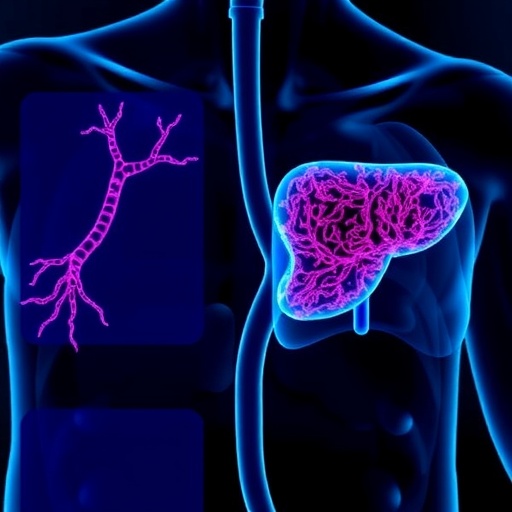In a groundbreaking study drawing on the extensive data from the UK Biobank, researchers have unveiled compelling evidence linking muscle strength and muscle mass with the risk of developing pancreatic cancer (PC). The findings, poised to reshape preventive strategies, emphasize the nuanced and sex-specific relationships between physical capability and pancreatic cancer incidence, marking a notable advance in the understanding of this aggressive malignancy.
Pancreatic cancer remains one of the deadliest cancers worldwide, often diagnosed at advanced stages with limited treatment options and poor prognosis. While sarcopenia, characterized by a progressive loss of skeletal muscle mass and strength, has been associated with worse outcomes in patients already diagnosed with pancreatic cancer, prospective studies exploring whether muscle health factors play a role in the etiology or risk prediction of PC have been scarce. This study fills that critical gap, investigating how baseline measures of muscle mass and grip strength relate to future pancreatic cancer risk.
Leveraging data from an impressively large cohort of 363,693 participants from the UK Biobank, the research team utilized objective measures of muscle strength and muscle quantity. Grip strength was assessed dynamically using standardized dynamometers, while muscle mass was estimated through bioelectrical impedance analysis (BIA), a non-invasive technique that evaluates body composition by measuring electrical conductivity across muscle and fat tissues. The muscle mass was normalized to body weight to account for individual differences in size and adiposity.
.adsslot_Wkd9N1iF5c{ width:728px !important; height:90px !important; }
@media (max-width:1199px) { .adsslot_Wkd9N1iF5c{ width:468px !important; height:60px !important; } }
@media (max-width:767px) { .adsslot_Wkd9N1iF5c{ width:320px !important; height:50px !important; } }
ADVERTISEMENT
Over a median follow-up period of 13.7 years, participants were closely monitored for the development of pancreatic cancer, allowing the researchers to apply rigorous Cox proportional hazards models adjusted for relevant confounders, including age, sex, lifestyle variables such as smoking and physical activity, and components of metabolic syndrome—an established cluster of risk factors including hypertension, insulin resistance, and dyslipidemia.
The analyses revealed a linear inverse association between both muscle mass and grip strength with incident pancreatic cancer risk. Specifically, individuals with higher muscle mass had a hazard ratio (HR) of 0.86, indicating a 14% lower risk per unit increase, while higher grip strength corresponded to a 10% risk reduction (HR = 0.90). These statistics underscore the protective influence of skeletal muscle health against pancreatic carcinogenesis, independent of other known risk factors.
Further interrogation of the data uncovered intriguing sex-specific differences. The protective effect conferred by greater muscle mass was more pronounced among men (HR = 0.84), suggesting muscle quantity plays a prominent role in male pancreatic cancer prevention. In contrast, grip strength—a functional measure capturing muscle quality and neuromuscular function—exerted stronger benefits in women (HR = 0.84). This divergence hints at underlying biological mechanisms differentiating how muscle attributes influence cancer risk in men versus women.
Delving deeper, subgroup analyses highlighted how metabolic health shapes these associations. Among participants living with diabetes, an acknowledged risk enhancer for pancreatic cancer, improved grip strength was linked to a significant 11% reduction in cancer risk (HR = 0.89). Meanwhile, obese individuals benefitted from both higher grip strength (HR = 0.95) and muscle mass (HR = 0.88), emphasizing the multifaceted interplay between muscle health and metabolic dysfunction in modulating pancreatic carcinogenesis.
From a public health perspective, the study’s population-attributable fraction estimates imply that between 5 to 12 percent of pancreatic cancer cases could potentially be prevented through interventions aimed at enhancing muscle strength and mass. These figures illuminate muscle preservation not only as a therapeutic target in already diagnosed patients but as a critical component of primary prevention strategies.
Mechanistically, the protective effect of muscle health may be multifactorial. Skeletal muscle functions as an endocrine organ, secreting myokines with anti-inflammatory properties and modulating systemic metabolism. Improved muscle composition may attenuate chronic low-grade inflammation and mitigate insulin resistance, both influential players in the initiation and progression of pancreatic malignancy. Moreover, enhanced physical function may support immune surveillance mechanisms critical for the early elimination of transformed cells.
These findings dovetail with emerging paradigms positioning sarcopenia and muscle dysfunction not merely as comorbidities or consequences of cancer but as independent risk factors contributing to cancer development. Recognizing muscle health as a modifiable risk determinant reinforces the importance of integrating resistance training and nutritional optimization into public health guidelines aimed at cancer prevention.
The study also prompts a reevaluation of risk stratification models for pancreatic cancer. Current predictive tools largely focus on age, family history, smoking, and metabolic conditions. The inclusion of precise muscle metrics, such as grip strength and BIA-estimated muscle mass, could refine risk prediction algorithms, enabling more personalized surveillance and early detection efforts tailored to sex and metabolic risk profiles.
Considering the observed sex-specific associations, preventive interventions might require customization. For men, programs emphasizing muscle mass augmentation through resistance exercises and dietary protein optimization may yield maximal benefit. For women, interventions targeting improvements in muscle strength and neuromuscular function, possibly integrating balance and functional training, could be prioritized, particularly within high-risk groups like those with diabetes or obesity.
While the study’s robust methodology and large sample size confer high credibility, certain limitations warrant consideration. Bioelectrical impedance analysis, while practical in large cohorts, is less precise than imaging modalities like MRI or DXA scans for muscle quantification. Additionally, grip strength, though a widely accepted surrogate for overall muscular fitness, captures a limited spectrum of muscle function. Future research integrating comprehensive muscle assessments and elucidating biological pathways will further clarify these associations.
This pioneering investigation lays fertile ground for clinical trials exploring whether boosting muscle health can tangibly reduce pancreatic cancer incidence. Such efforts could revolutionize preventive oncology, positioning exercise physiology and metabolic health at the forefront of cancer risk reduction.
In sum, this landmark study from Liu, Song, Li, et al., published in BMC Cancer, illuminates the vital role that muscle strength and muscle mass play in shaping pancreatic cancer risk. Their nuanced, sex-specific insights advocate for a paradigm shift in cancer prevention strategies, underscoring the imperative to maintain muscle health as an integral component of metabolic and oncologic resilience. These revelations herald a new frontier in the battle against one of the world’s most formidable cancers.
Subject of Research:
The prospective association between muscle strength, muscle mass, and pancreatic cancer risk.
Article Title:
Muscle strength and mass as predictors of pancreatic cancer: insights from the UK biobank.
Article References:
Liu, X., Song, H., Li, C. et al. Muscle strength and mass as predictors of pancreatic cancer: insights from the UK biobank. BMC Cancer 25, 1346 (2025). https://doi.org/10.1186/s12885-025-14766-w
Image Credits: Scienmag.com
DOI: https://doi.org/10.1186/s12885-025-14766-w
Tags: cancer research and muscle healthetiology of pancreatic cancerfuture risk prediction in pancreatic cancergrip strength and health outcomesmuscle mass and cancer preventionmuscle strength and pancreatic cancer risknon-invasive muscle assessment techniquespreventive strategies for pancreatic cancersarcopenia and pancreatic cancer outcomessex-specific cancer risk factorsskeletal muscle health and malignancyUK Biobank study on cancer





